Overcomplete Autoencoders with PyTorch¶
Run Jupyter Notebook
You can run the code for this section in this jupyter notebook link.
Introduction¶
- Recap!
- An autoencoder's purpose is to learn an approximation of the identity function (mapping \(x\) to \(\hat x\)).
- Essentially we are trying to learn a function that can take our input \(x\) and recreate it \(\hat x\).
- Technically we can do an exact recreation of our in-sample input if we use a very wide and deep neural network.
- Essentially we are trying to learn a function that can take our input \(x\) and recreate it \(\hat x\).
- An autoencoder's purpose is to learn an approximation of the identity function (mapping \(x\) to \(\hat x\)).
- In this particular tutorial, we will be covering denoising autoencoder through overcomplete encoders.
- Essentially given noisy images, you can denoise and make them less noisy with this tutorial through overcomplete encoders.
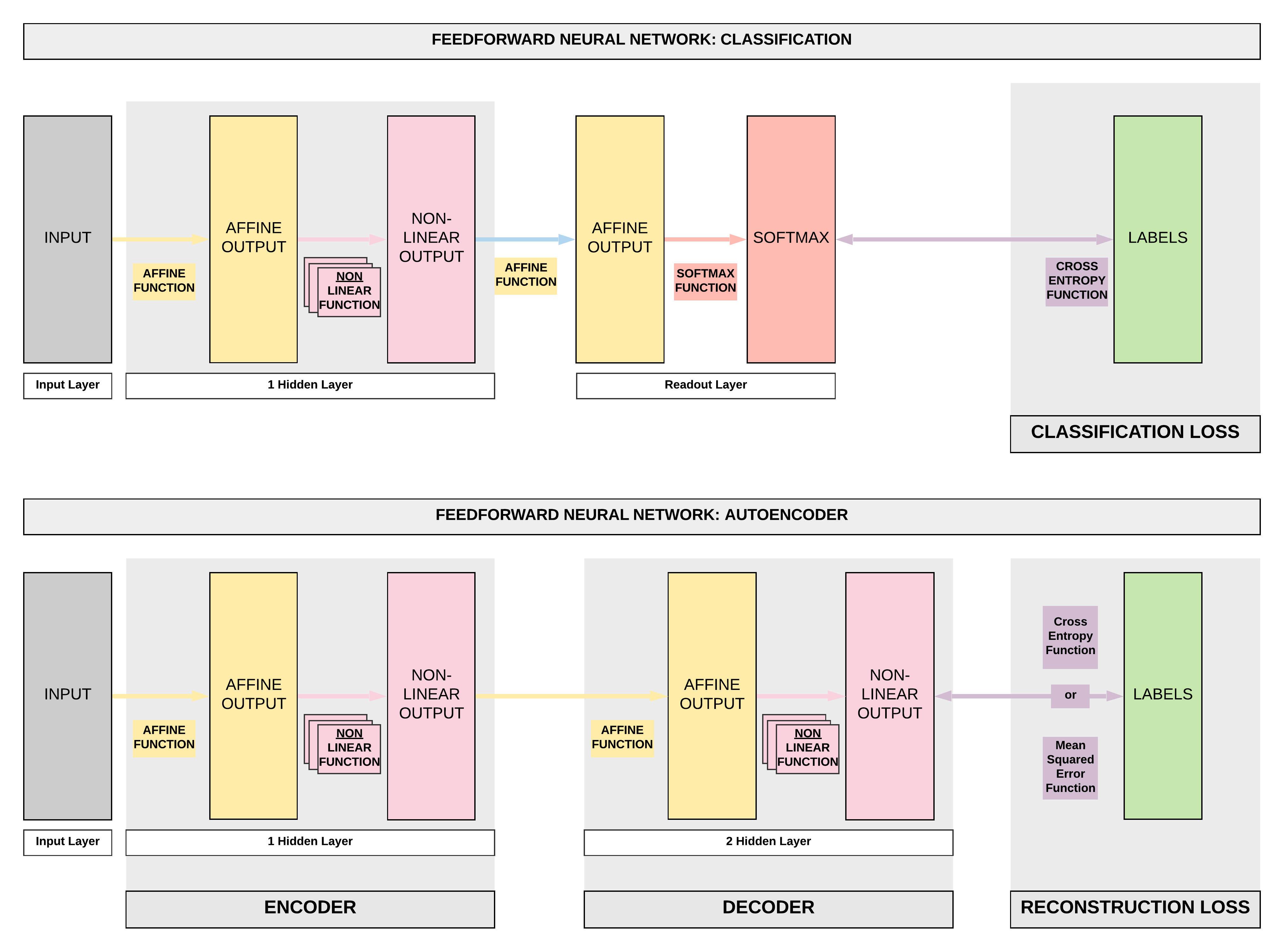
Fashion MNIST Dataset Exploration¶
Imports¶
import torch
import torch.nn as nn
import torch.nn.functional as F
import torchvision.transforms as transforms
import torchvision.datasets as dsets
import matplotlib.pyplot as plt
import numpy as np
%matplotlib inline
figsize=(15, 6)
plt.style.use('fivethirtyeight')
| Name | Content | Examples | Size | Link | MD5 Checksum |
|---|---|---|---|---|---|
train-images-idx3-ubyte.gz |
training set images | 60,000 | 26 MBytes | Download | 8d4fb7e6c68d591d4c3dfef9ec88bf0d |
train-labels-idx1-ubyte.gz |
training set labels | 60,000 | 29 KBytes | Download | 25c81989df183df01b3e8a0aad5dffbe |
t10k-images-idx3-ubyte.gz |
test set images | 10,000 | 4.3 MBytes | Download | bef4ecab320f06d8554ea6380940ec79 |
t10k-labels-idx1-ubyte.gz |
test set labels | 10,000 | 5.1 KBytes | Download | bb300cfdad3c16e7a12a480ee83cd310 |
Load Dataset (Step 1)¶
- Typically we've been leveraging on
dsets.MNIST(), now we simply change todsets.FashionMNIST!
# Fashion-MNIST data loader
train_dataset = dsets.FashionMNIST(root='./data',
train=True,
transform=transforms.ToTensor(),
download=True)
test_dataset = dsets.FashionMNIST(root='./data',
train=False,
transform=transforms.ToTensor())
Downloading http://fashion-mnist.s3-website.eu-central-1.amazonaws.com/train-images-idx3-ubyte.gz
Downloading http://fashion-mnist.s3-website.eu-central-1.amazonaws.com/train-labels-idx1-ubyte.gz
Downloading http://fashion-mnist.s3-website.eu-central-1.amazonaws.com/t10k-images-idx3-ubyte.gz
Downloading http://fashion-mnist.s3-website.eu-central-1.amazonaws.com/t10k-labels-idx1-ubyte.gz
Processing...
Done!
Load Data Loader (Step 2)¶
# Batch size, iterations and epochs
batch_size = 100
n_iters = 5000
num_epochs = n_iters / (len(train_dataset) / batch_size)
num_epochs = int(num_epochs)
train_loader = torch.utils.data.DataLoader(dataset=train_dataset,
batch_size=batch_size,
shuffle=True)
test_loader = torch.utils.data.DataLoader(dataset=test_dataset,
batch_size=batch_size,
shuffle=False)
Labels¶
Each training and test example is assigned to one of the following labels:
| Label | Description |
|---|---|
| 0 | T-shirt/top |
| 1 | Trouser |
| 2 | Pullover |
| 3 | Dress |
| 4 | Coat |
| 5 | Sandal |
| 6 | Shirt |
| 7 | Sneaker |
| 8 | Bag |
| 9 | Ankle boot |
Sample: Boot¶
# Sample 0: boot
sample_num = 0
show_img = train_dataset[sample_num][0].numpy().reshape(28, 28)
label = train_dataset[sample_num][1]
print(f'Label {label}')
plt.imshow(show_img, cmap='gray');
Label 9
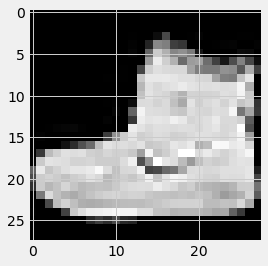
Sample: shirt¶
# Sample 1: shirt
sample_num = 1
show_img = train_dataset[sample_num][0].numpy().reshape(28, 28)
label = train_dataset[sample_num][1]
print(f'Label {label}')
plt.imshow(show_img, cmap='gray');
Label 0
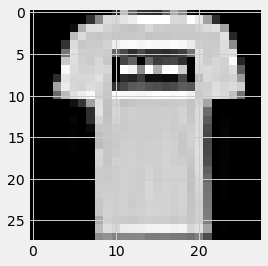
Sample: dress¶
# Sample 3: dress
sample_num = 3
show_img = train_dataset[sample_num][0].numpy().reshape(28, 28)
label = train_dataset[sample_num][1]
print(f'Label {label}')
plt.imshow(show_img, cmap='gray');
Label 3
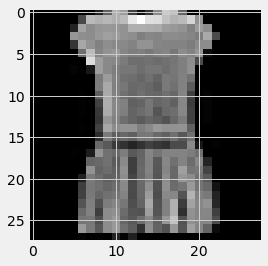
Maximum/minimum pixel values¶
- Pixel values range from 0 to 1
min_pixel_value = train_dataset[sample_num][0].min()
max_pixel_value = train_dataset[sample_num][0].max()
print(f'Minimum pixel value: {min_pixel_value}')
print(f'Maximum pixel value: {max_pixel_value}')
Minimum pixel value: 0.0
Maximum pixel value: 1.0
Overcomplete Autoencoder¶
Sigmoid Function¶
- Sigmoid function was introduced earlier, where the function allows to bound our output from 0 to 1 inclusive given our input.
- This is introduced and clarified here as we would want this in our final layer of our overcomplete autoencoder as we want to bound out final output to the pixels' range of 0 and 1.
# Sigmoid function has function bounded by min=0 and max=1
# So this will be what we will be using for the final layer's function
x = torch.arange(-10., 10., 0.1)
plt.figure(figsize=figsize);
plt.plot(x.numpy(), torch.sigmoid(x).numpy())
plt.title('Sigmoid Function')
Text(0.5, 1.0, 'Sigmoid Function')
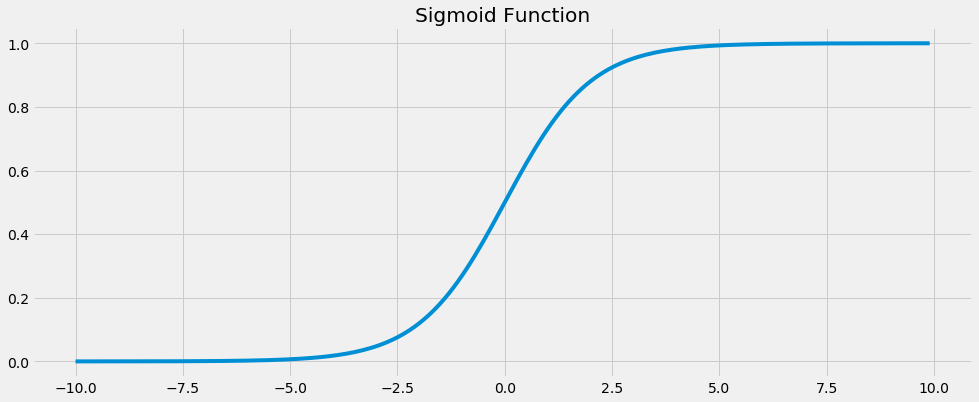
Steps¶
- These steps should be familiar by now! Our famous 7 steps. But I will be adding one more step here, Step 8 where we run our inference.
- Step 1: Load Dataset
- Step 2: Make Dataset Iterable
- Step 3: Create Model Class
- Step 4: Instantiate Model Class
- Step 5: Instantiate Loss Class
- Step 6: Instantiate Optimizer Class
- Step 7: Train Model
- Step 8: Model Inference
Step 3: Create Model Class¶
# Model definition
class FullyConnectedAutoencoder(nn.Module):
def __init__(self, input_dim, hidden_dim, output_dim):
super().__init__()
# Encoder: affine function
self.fc1 = nn.Linear(input_dim, hidden_dim)
# Decoder: affine function
self.fc2 = nn.Linear(hidden_dim, output_dim)
def forward(self, x):
# Encoder: affine function
out = self.fc1(x)
# Encoder: non-linear function
out = F.leaky_relu(out)
# Decoder: affine function
out = self.fc2(out)
# Decoder: non-linear function
out = torch.sigmoid(out)
return out
Step 4: Instantiate Model Class¶
# Dimensions for overcomplete (larger latent representation)
input_dim = 28*28
hidden_dim = int(input_dim * 1.5)
output_dim = input_dim
# Instantiate Fully-connected Autoencoder (FC-AE)
# And assign to model object
model = FullyConnectedAutoencoder(input_dim, hidden_dim, output_dim)
Step 5: Instantiate Loss Class¶
# We want to minimize the per pixel reconstruction loss
# So we've to use the mean squared error (MSE) loss
# This is similar to our regression tasks' loss
criterion = nn.MSELoss()
Step 6: Instantiate Optimizer Class¶
# Using basic Adam optimizer
learning_rate = 1e-3
optimizer = torch.optim.Adam(model.parameters(), lr=learning_rate)
Inspect Parameter Groups¶
# Parameter inspection
num_params_group = len(list(model.parameters()))
for group_idx in range(num_params_group):
print(list(model.parameters())[group_idx].size())
torch.Size([1176, 784])
torch.Size([1176])
torch.Size([784, 1176])
torch.Size([784])
Step 7: Train Model¶
- Take note there's a critical line of
dropout = nn.Dropout(0.5)here which basically allows us to make noisy images from our original Fashion MNIST images. - It basically drops out 50% of all pixels randomly.
idx = 0
# Dropout for creating noisy images
# by dropping out pixel with a 50% probability
dropout = nn.Dropout(0.5)
for epoch in range(num_epochs):
for i, (images, labels) in enumerate(train_loader):
# Load images with gradient accumulation capabilities
images = images.view(-1, 28*28).requires_grad_()
# Noisy images
noisy_images = dropout(torch.ones(images.shape)) * images
# Clear gradients w.r.t. parameters
optimizer.zero_grad()
# Forward pass to get output
outputs = model(noisy_images)
# Calculate Loss: MSE Loss based on pixel-to-pixel comparison
loss = criterion(outputs, images)
# Getting gradients w.r.t. parameters via backpropagation
loss.backward()
# Updating parameters via gradient descent
optimizer.step()
idx += 1
if idx % 500 == 0:
# Calculate MSE Test Loss
total_test_loss = 0
total_samples = 0
# Iterate through test dataset
for images, labels in test_loader:
# Noisy images
noisy_images = dropout(torch.ones(images.shape)) * images
# Forward pass only to get logits/output
outputs = model(noisy_images.view(-1, 28*28))
# Test loss
test_loss = criterion(outputs, images.view(-1, 28*28))
# Total number of labels
total_samples += labels.size(0)
# Total test loss
total_test_loss += test_loss
mean_test_loss = total_test_loss / total_samples
# Print Loss
print(f'Iteration: {idx}. Average Test Loss: {mean_test_loss.item()}.')
Iteration: 500. Average Test Loss: 0.0001664187147980556.
Iteration: 1000. Average Test Loss: 0.00014121478307060897.
Iteration: 1500. Average Test Loss: 0.0001341506722383201.
Iteration: 2000. Average Test Loss: 0.0001252180663868785.
Iteration: 2500. Average Test Loss: 0.00012206179235363379.
Iteration: 3000. Average Test Loss: 0.00011766648094635457.
Iteration: 3500. Average Test Loss: 0.00011584569438127801.
Iteration: 4000. Average Test Loss: 0.00011396891932236031.
Iteration: 4500. Average Test Loss: 0.00011224475019844249.
Model Inference¶
Raw Sample 1¶
# Test sample: Raw
sample_num = 10
raw_img = test_dataset[sample_num][0]
show_img = raw_img.numpy().reshape(28, 28)
label = test_dataset[sample_num][1]
print(f'Label {label}')
plt.imshow(show_img, cmap='gray');
Label 4
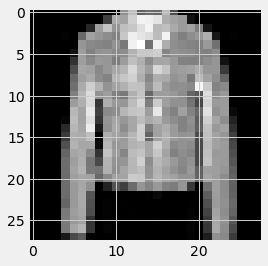
Test Sample 1: Noisy to Denoised¶
# Test sample: Noisy
sample_num = 10
raw_img = test_dataset[sample_num][0]
noisy_image = dropout(torch.ones(raw_img.shape)) * raw_img
show_img = noisy_image.numpy().reshape(28, 28)
label = test_dataset[sample_num][1]
print(f'Label {label}')
plt.imshow(show_img, cmap='gray');
Label 4
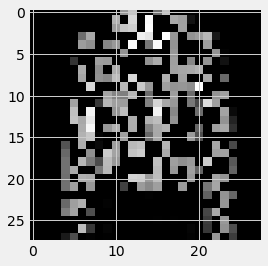
Summary¶
- Introduction
- Recap of Autoencoders
- Introduction of denoising autoencoders
- Dataset Exploration
- Fashion MNIST
- 10 classes
- Similar to MNIST but fashion images instead of digits
- Fashion MNIST
- 8 Step Model Building Recap
- Step 1: Load Dataset
- Step 2: Make Dataset Iterable
- Step 3: Create Model Class
- Step 4: Instantiate Model Class
- Step 5: Instantiate Loss Class
- Step 6: Instantiate Optimizer Class
- Step 7: Train Model
- Step 8: Model Inference
- Raw Sample 1
- Noisy to Denoised Sample 1